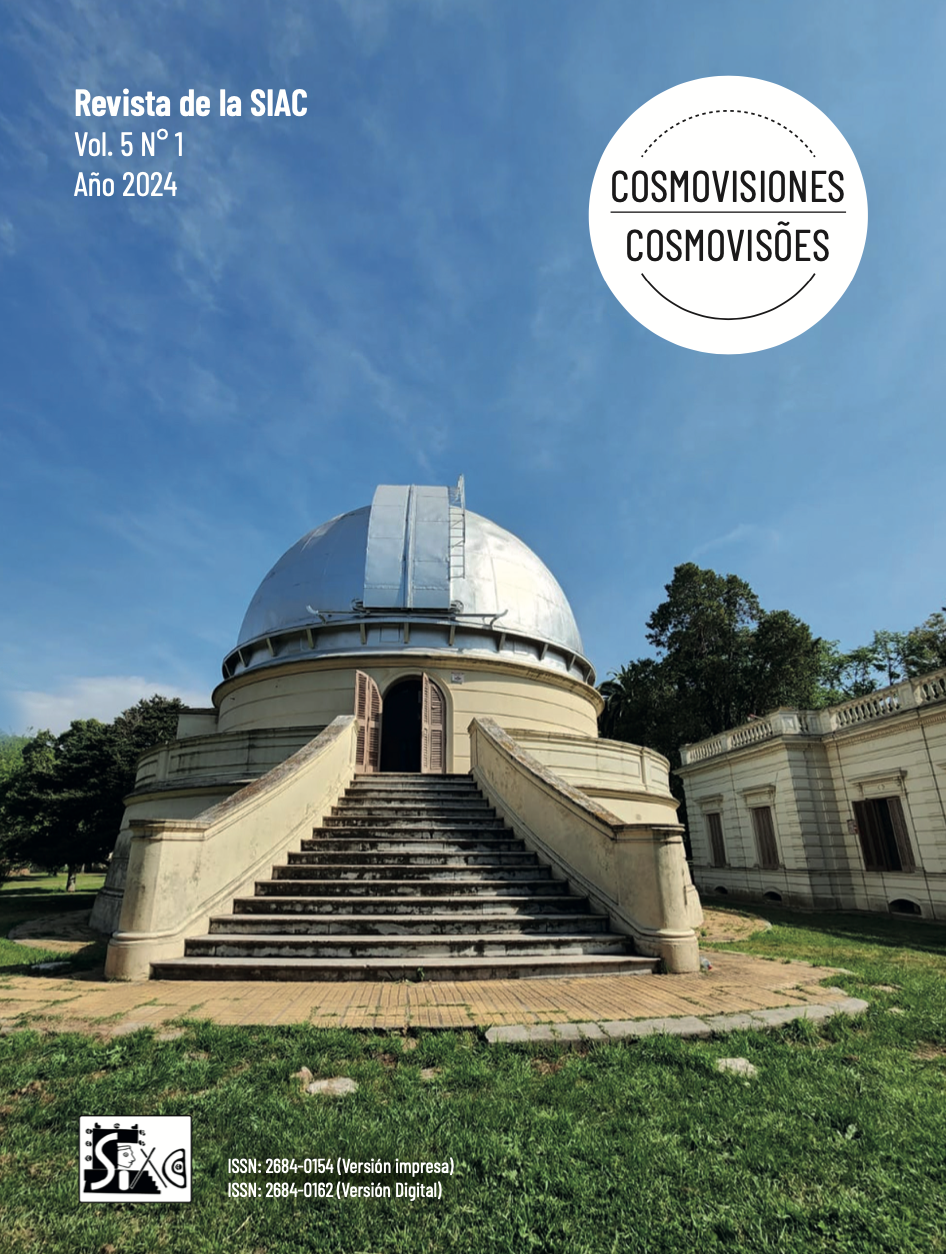Comparación de los paisajes terrestres y celestes de las tres principales tierras señoriales-conquistadas en las Islas Canarias
DOI:
https://doi.org/10.24215/26840162e016Palabras clave:
Islas Canarias, iglesias, orientaciones, arqueoastronomía, orografíaResumen
Este trabajo es un estudio de la relación entre astronomía y paisaje centrado en la orientación de las iglesias cristianas de las tres Islas de Señorío principales del archipiélago canario (España): Lanzarote, La Gomera y Fuerteventura. Como antecedente tenemos la información que nos brindan los textos de los primeros escritores cristianos, que prescribían que las iglesias debían estar orientadas hacia el oriente.
Realizamos un estudio comparativo entre estas tres islas para comprobar si los patrones de orientación de los templos guardan alguna relación entre sí, o con los de las iglesias de Europa continental. Nos interesa explorar en qué medida se respetaron las indicaciones de los primeros textos sobre arquitectura cristiana y en qué medida los templos se orientan eventualmente siguiendo diferentes alineaciones, por ejemplo, según tradiciones aborígenes preexistentes. También nos interesa saber si existen iglesias que estén orientadas hacia puntos del horizonte por los que sale el Sol el día de las fiestas patronales, ya que esa costumbre fue sugerida en varios estudios previos. El análisis de los pocos casos en los que se comprobó esta coincidencia calendárica en Lanzarote y La Gomera se amplía ahora con el medio centenar de iglesias que se midieron en Fuerteventura.
El trabajo de campo que sustenta nuestro estudio comparativo se basa en la medición precisa de las coordenadas de ubicación, acimut del eje y altura angular del horizonte para la mayoría de las iglesias de las tres islas, lo que suma alrededor de 120 conjuntos de mediciones. Para el estudio de la muestra se han empleado diversos análisis, tanto estadísticos como calendáricos y orográficos.
Nuestros resultados muestran que en todas las islas se repite el patrón de dobles orientaciones, que contempla la tradición canónica de orientar los altares de las iglesias dentro del rango solar (hacia el oriente o hacia el occidente). También se dan muy pocos casos en los que es posible identificar construcciones cuya orientación sigue patrones solsticiales, tal vez como imitación del culto aborigen. Pero este doble patrón también incluye una alta proporción de iglesias con orientaciones alejadas del rango solar. Un ejemplo son Lanzarote y Fuerteventura, ambas islas sometidas al mismo flujo de los vientos alisios predominantes en la región, pero cada una con sus propias características. Otro ejemplo lo da la particular orografía de los profundos barrancos de La Gomera, que determina la orientación de los templos situados en esos accidentes geográficos.
En este trabajo mostramos cómo la combinación de elementos de los paisajes terrestre y celeste puede, con un alto grado de probabilidad, ofrecer una explicación satisfactoria a la particular orientación de estos centros de culto insulares, que se construyeron durante las primeras décadas posteriores a la conquista europea.
Descargas
Citas
Arneitz, P., Draxler, A., Rauch, R. and Leonhardt, R. (2014) Orientation of churches by magnetic compasses? Geophysical Journal International 198 (1): 1-7.
Aznar, E., Pico, B. and Corbella, D. (2003) Le Canarien. Manuscritos, transcripción y traducción. La Laguna: Instituto de Estudios Canarios.
Belmonte, J. A. (2015) Pre-Hispanic Sanctuaries in the Canary Islands. In Ruggles, C. (ed.) Handbook of Archaeoastronomy and Ethnoastronomy. New York: Springer. 1115-1124.
Cioranescu, A. (1987) Jean de Béthencourt en Fuerteventura. In I Jornadas de Historia de Fuerteventura y Lanzarote, Tomo II. Puerto del Rosario: Servicio de publicaciones del Cabildo de Fuerteventura. 531-546.
Di Paolo, A., Gangui, A., Belmonte, J. A. and Perera-Betancor, M. A.(2020) Cuando la ortodoxia no es lo más relevante: el paisaje de La Gomera y la orientación de sus iglesias. Cosmovisiones/Cosmovisões 1(1): 73-88.
Gangui, A., González-García, A. C., Perera Betancort, M. A. and Belmonte, J. A. (2016) La orientación como una seña de identidad cultural: las iglesias históricas de Lanzarote. Tabona 20: 105-128.
González-García, A. C. and Belmonte, J. A. (2015) The Orientation of Pre-Romanesque Churches in the Iberian Peninsula. Nexus Network Journal 17 (2): 353-377.
McCluskey, S. C. (2015) Orientation of Christian Churches. In Ruggles, C. (ed.) Handbook of Archaeoastronomy and Ethnoastronomy. New York: Springer.1703-10.
Muratore, M.F., Gangui, A., Urrutia-Aparicio, M., Cabrera, C. and Belmonte, J. A.(2023) On the orientation of historic Christian churches of Fuerteventura: conciliating tradition, winds and topography Journal of Skyscape Archaeology9.1: 5-31.
Porro Gutiérrez, J.M. (2000) El reflejo de las Islas Canarias en la cartografía anterior al siglo XVI. EnMorales Padrón, F. (coord.) XIII Coloquio de Historia Canario-americana; VIII Congreso Internacional de Historia de América (AEA; 1998). 3305-22.
Urrutia-Aparicio, M., González-García, A.C. and Belmonte, J.A. (2021). East or Easter? Keys to the orientation of Romanesque churches along the Way of Saint James. Journal for the History of Astronomy 52: 289-310.
Vogel, C. (1962) Sol aequinoctialis. Problèmes et technique de l'orientationdans le culte chrétien. Revue des SciencesReligieuses 36: 175-211.
Descargas
Publicado
Cómo citar
Número
Sección
Licencia
Derechos de autor 2024 María Florencia Muratore, Alejandro Gangui, Juan Antonio Belmonte, Carmelo Cabrera

Esta obra está bajo una licencia internacional Creative Commons Atribución-NoComercial-CompartirIgual 4.0.
Los autores que publican en esta revista están de acuerdo con los siguientes términos:
Los autores conservan la autoría intelectual del trabajo y garantizan a la revista el derecho de ser la primera publicación del trabajo.
Los autores pueden compartir el trabajo con un reconocimiento de la autoría y la publicación inicial en esta revista.
Los autores pueden establecer por separado acuerdos adicionales para la distribución no exclusiva de la versión de la obra publicada en la revista (por ejemplo, situarlo en un repositorio institucional o publicarlo en un libro), con un reconocimiento de su publicación inicial en esta revista.
La revista ofrece acceso libre ("open access") a todo su contenido. Los artículos se encuentran disponibles para ser leídos, descargados, copiados, impresos y/o investigados de acuerdo a la licencia Creative Commons: CC BY-NC-SA (Atribución - No Comercial - Compartir Igual-4.0 Internacional)

El contenido de la revista queda completamente disponible a partir de su publicación. Los lectores tienen por obligación citar correctamente a la revista y al autor del contenido descargado
















